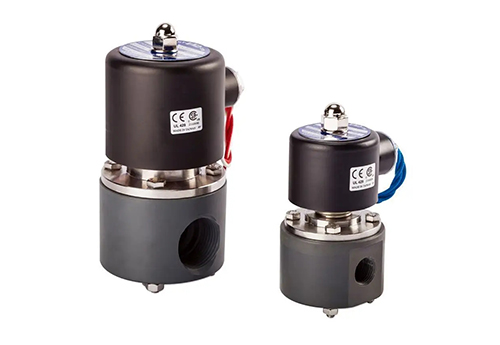Anti-corrosion solenoid valve Function
Anti-corrosion solenoid valve is suitable for use in various strong acid and alkali gases and liquids as working media, and is widely used in automated control systems such as medical pharmaceuticals, chemicals, environmental protection or cleaning equipment as medium pipelines On and off. The valve body is made of polytetrafluoroethylene (king of plastics), the diaphragm is made of fluororubber or polytetrafluoroethylene, and other parts are completely isolated from the liquid medium.
Anti-corrosion solenoid valveDue to the uniqueness of the opening and closing principle and the scientific structural design, all parts of the product can be made of different polymer materials according to different chemical media. The return spring is set outside the medium, so it is not easy to block, It has the advantages of acid and alkali resistance, corrosion resistance and long service life. It can be adapted to various chemical fluid media and is a supporting product for chemical fluid automated production equipment. PTFE chemical solenoid valves have excellent corrosion resistance and are inert to all commonly used chemicals. Resistant to almost all chemical media (including concentrated sulfuric acid and aqua regia). It has excellent heat resistance and is especially suitable for environments with severe corrosion, high temperatures and where chemicals are not allowed to come into contact with lubricants.

Principle of anti-corrosion solenoid valve
< br/>
Normally closed: When the coil is energized, the pilot spool When the coil is closed, the pilot hole opens, the pressure in the upper chamber of the valve is relieved, the piston is pushed by the medium pressure in the lower chamber, and the solenoid valve opens;when the coil is powered off, the pilot spool is reset by the spring, the pilot hole is closed, and the upper chamber of the valve is controlled by the piston orifice. The solenoid valve closes due to the thrust of the boosting and return springs.
Normally open: When the coil is powered on, the pilot hole is closed, the upper cavity of the valve is pressurized by the piston orifice and the thrust of the return spring, and the solenoid valve is closed;when the coil is powered off, the pilot spool is reset by the spring, and the pilot hole is opened. The pressure in the upper chamber of the valve is relieved, the piston is pushed by the medium pressure in the lower chamber, and the anti-corrosion solenoid valve opens.
Precautions for anti-corrosion solenoid valves
1. When installing, please note that the arrow on the valve body should be consistent with the flow direction of the medium. Do not install in places with direct dripping or splashing water. The solenoid valve should be installed vertically upward.
2. The anti-corrosion solenoid valve should ensure that the power supply voltage It works normally within the fluctuation range of 15%-10% of the rated voltage.
3. After the anti-corrosion solenoid valve is installed, the There must be no reverse pressure differential. And it needs to be powered on several times to make it suitable for temperature before it can be officially put into use.
4. Solenoid Valve The pipes should be thoroughly cleaned before installation. The incoming medium should be free of impurities. Install filter before valve.
5. When the solenoid valve fails or is cleaned , to ensure that the system continues to operate, a bypass device should be installed.
The above isFunction of anti-corrosion solenoid valve, principle of anti-corrosion solenoid valve Content introduction, want to know more about it Information can be viewed at www.diancifa.cc.






 WhatsApp: +8615857777578
WhatsApp: +8615857777578